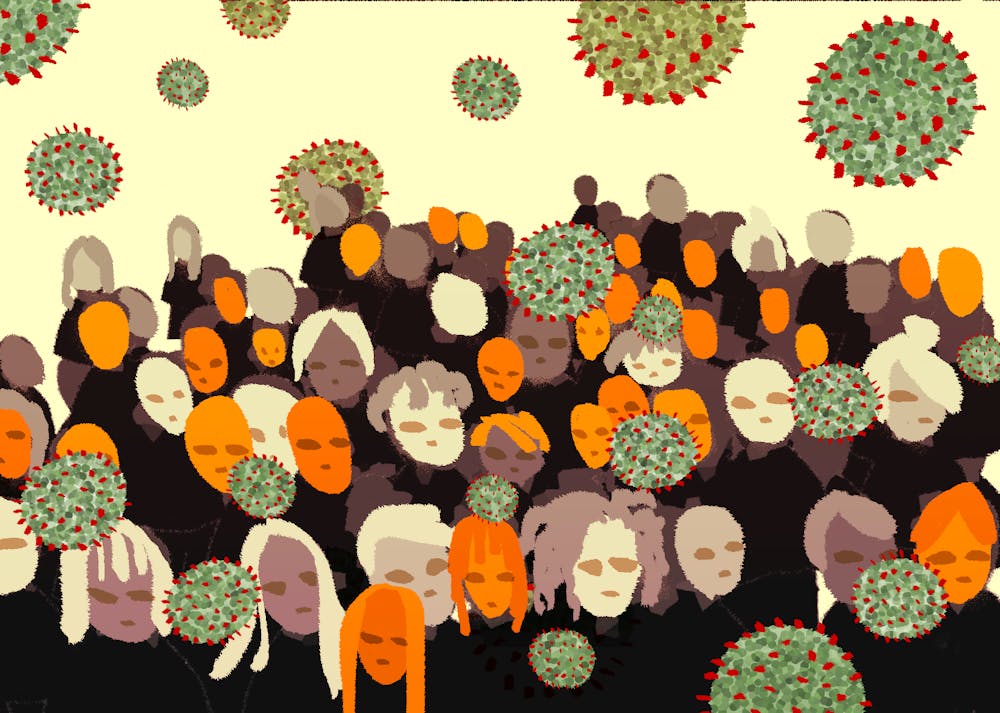With COVID-19 cases on the rise, new information on superspreading surfacing and the impending holiday season, some ASU professors fear even more dramatic increases in cases.
Biodesign Institute Executive Director Joshua LaBaer said in an Oct. 21 press conference that numbers had been increasing exponentially.
Throughout October and early November, cases throughout Arizona have been steadily increasing. The state reported a seven-day trailing average of 1,650 new cases and over 9,000 cases over the past five days, according to ASU Biodesign Institute's Critical COVID-19 trends page.
“We are not potentially in a surge, I would say we are in a surge," LaBaer said. "I don’t think there’s any doubt in my mind.”
Active cases within the ASU community increased from 170 on Nov. 5 to 288 as of Nov. 9. LaBaer attributed the surges to a general feeling of COVID fatigue. A relaxation of the public's mindset regarding guarding against COVID-19 may lead to superspreader events in the coming months.
A research article from Science Magazine found that in southern India around 5% of infected patients were responsible for 80% of new cases. A small population is responsible for such a level of transmission due to superspreaders, individuals who transmit an infectious disease significantly more than the average person.
Megan Jehn, an associate professor at the School of Human Evolution and Social Change who oversees the ASU COVID-19 Response Team, said the holiday season is dangerous territory for superspreader events. She encourages students to get tested before leaving for the holidays and to consider having family gatherings outdoors.
“I think the holiday naturally brings together large gatherings indoors," Jehn said. "Close spaces, crowds and contact that are associated with super spreader events are all the types of gatherings that we see over the holidays.”
Jehn said to avoid super spreaders, people should stray away from the "three Cs": Close spaces with poor ventilation, crowds and close-contact settings.
Jehn said scientists still aren't quite certain why superspreaders are more likely to spread the virus.
"I wouldn’t say that we have concrete data, but I think most scientists are hypothesizing that there probably could be a combination of biological and behavioral factors involved," Jehn said.
Jehn oversees contact tracing through ASU's COVID-19 Response Team. She said students have been traced to superspreader events in Maricopa County but could not comment on specific events. Jehn said she believes ASU's campus is a safe place for students.
Heather Ross, clinical assistant professor at the Edson College of Nursing and Health Innovation, advises students leaving for the holidays to not get tested one to two days after potential exposure to COVID-19, because there may not be enough of the virus replicated to be detected.
“In that three to five day period after you’ve been exposed, we’re pretty confident that you’ll test positive,” Ross said “If you have been partying with your friends from home and they’re not part of your normal household, please don’t go and infect your parents and grandparents and other relatives.”
LaBaer said superspreader events are not just large gatherings but events with a superspreader present. LaBaer cited recent examples such as the Sturgis Motorcycle Rally and the White House Rose Garden event for Supreme Court Justice Amy Coney Barrett.
“As soon as you get to numbers like 30 people, the likelihood that someone in that group is a potential superspreader is very high,” LaBaer said.
According to the Tempe Police Department, 20 party citations were issued Halloween weekend. Jehn said the number of parties over Halloween weekend had the potential for a superspreader, and she expected an increase in cases from these gatherings.
“It is more important now than ever that people are careful, and that people wear a mask and don’t go out with people that aren’t part of your household or part of your bubble,” Ross said.
Reach the reporter at tprober6@asu.edu
Like The State Press on Facebook and follow @statepress on Twitter.




